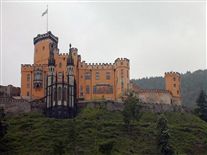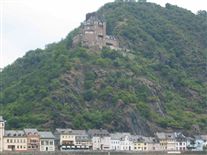Niederwalddenkmal-01c.jpg
Niederwalddenkmal (Germania) Monument - Click "Details" for more information
History:
The monument was constructed to commemorate the foundation of the German Empire after the end of Franco-Prussian War. The first stone was laid on September 16, 1871, by Wilhelm I. The sculptor was Johannes Schilling, and the architect was Karl Weisbach. The total cost of the work is estimated at one million gold marks. It was inaugurated on September 28, 1883. The 38 meter tall monument represents the union of all Germans.
The structure:
The central figure is the 10.5 meter tall Germania figure. In the sculptured impression, Germania holds the recovered crown of the emperor in the right hand and in the left the imperial sword.
Beneath Germania is a large relief that shows emperor Wilhelm I riding a horse with nobility, the army commanders and soldiers. The relief has the Wacht am Rhein (Watch on the Rhine) lyrics engraved.
On the left side of the monument is located the peace statue. The war statue is located on the right.
The inscription:
The monument's main inscription is engraved in the pedestal where the Germania statue is located: "ZUM ANDENKEN AN DIE EINMUETHIGE SIEGREICHE ERHEBUNG DES DEUTSCHEN VOLKES UND AN DIE WIEDERAUFRICHTUNG DES DEUTSCHEN REICHES 1870-1871." ("In memory of the unanimous victorious uprising of the German People and of the reinstitution of the German Empire 1870-1871"). The original idea by sculptor Johannes Schilling of the victory of the united German People was later adulterated into a more hostile interpretation against the "archenemy" France.
Location:
The Niederwald is a broad hill on the right bank of the Rhine, between that river and the Wisper, opposite Bingen am Rhein. The hill forms the southwestern apex of the Taunus range. Its summit is clothed with dense forests of oak and beech. Its southern and western sides, which descend sharply to Rüdesheim am Rhein and Assmannshausen on the Rhine, are covered with vineyards, and produce some of the finest wines of the district. The monument is located at the edge of the forest, on the crest of the hill above Rüdesheim.
Koblenz_im_Buga-Jahr_2011-Deutsches_Eck_where_the_rivers_Moselle_joins_the_Rhine-Holger_Weinandt.jpg
Koblenz, where the Moselle River joins the Rhine River



















